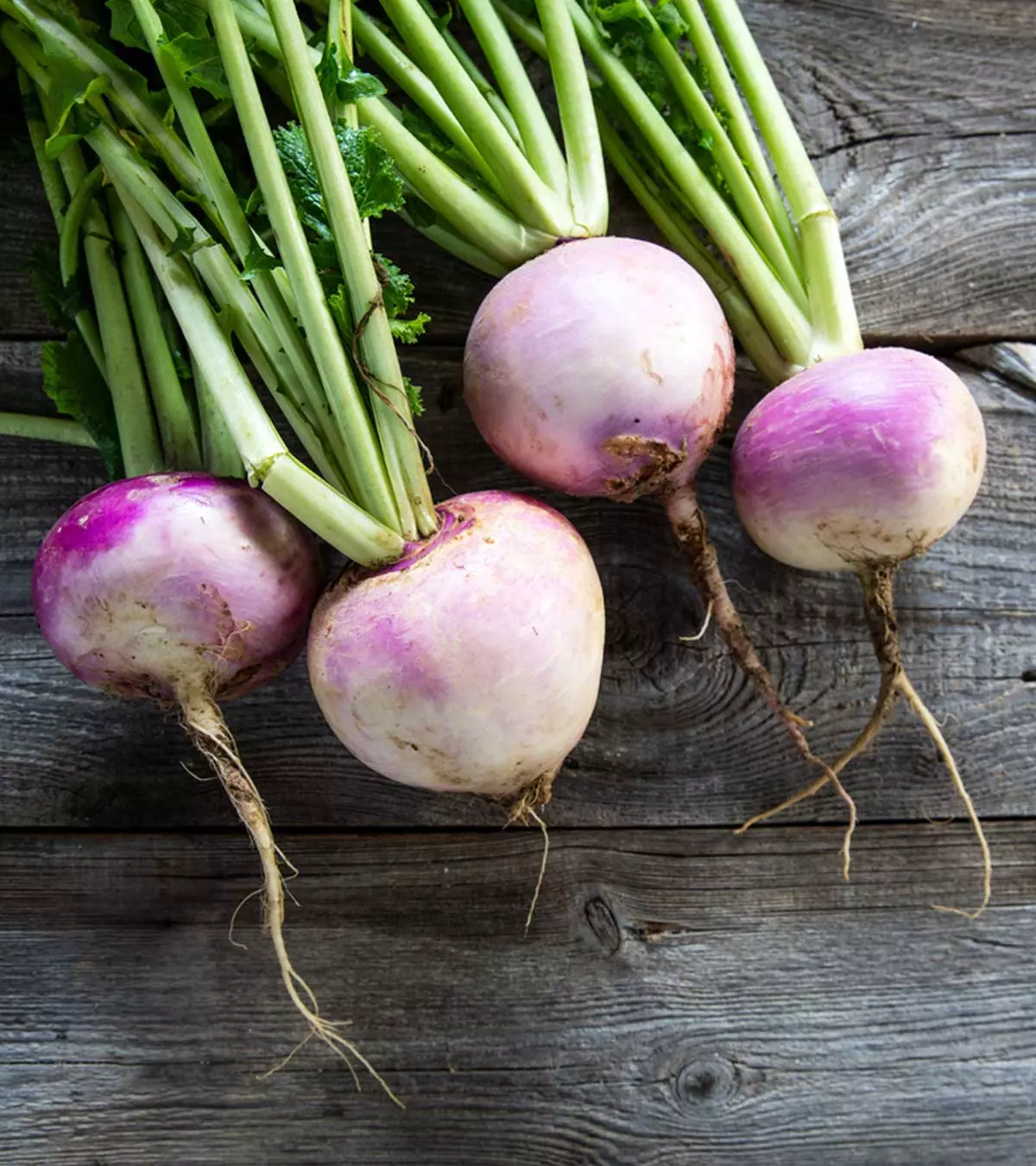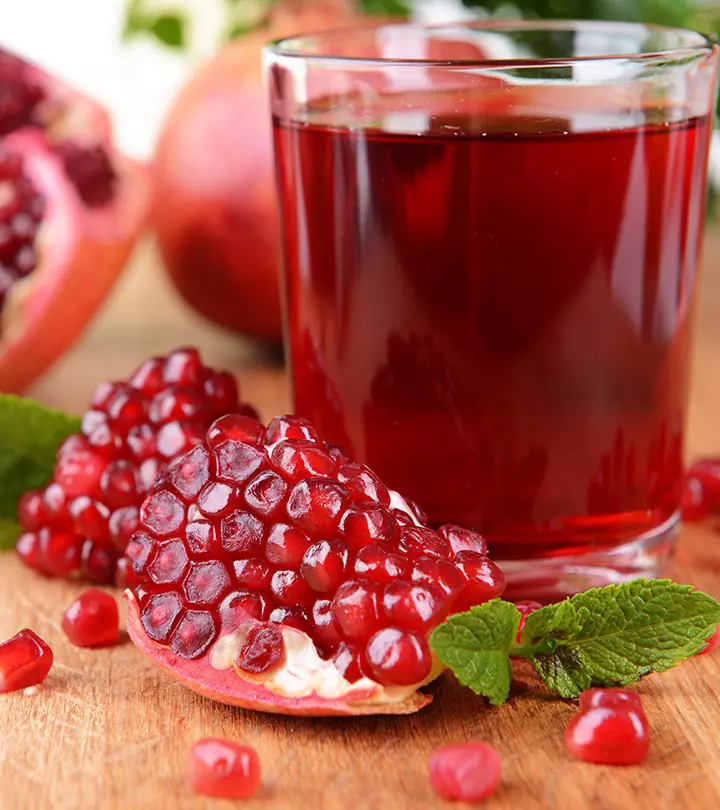
Image: Midjourney/ MomJunction Design Team
A 6-month-old baby diet chart helps parents understand how to introduce solid foods to children and know what the suitable options are. The American Academy of Pediatrics (AAP) recommends that all babies start solid food once they turn six months (1). Before this age, breastmilk can provide complete nutrition to them.

According to a study conducted by a researcher from NANTES University in France, breast milk is primarily composed of water (87%), followed by protein (1%), lipid (4%), and carbohydrates (4.6 to 6%). Additionally, breastmilk contains 1 to 2.4% oligosaccharides and a combination of essential vitamins and minerals (2). These nutrients are vital for overall health and well-being of infants, making breastmilk a crucial source of nutrition for them.
Blanca Garcia, a registered dietitian-nutritionist from Los Angeles, California, says, “Complementary feeding starts when a baby reaches six months of age. Breastmilk alone will no longer be sufficient to meet the baby’s increasing nutritional needs for energy, protein, vitamins like A and C, and minerals such as iron and zinc. The introduction of complementary foods—solid foods and liquids given in small quantities in addition to breastmilk—is a critical stage in a baby’s transition from breastmilk to eating solid foods.”
Soft fruits like bananas, peaches, and avocado, iron-fortified baby cereals, homemade purees, and protein-rich foods like blended meats, tofu, and lentils can make great first foods for your 6-month-old baby, providing important nutrients while also introducing them to new tastes and food textures. So, when you start introducing food to babies, you should remember that they cannot eat a lot initially, and breastmilk will be their primary source of nutrition (3). Gradually, you may try to replace the feed with some solid food. Refer to the post to understand various food options that may be introduced at six months, the precautions you should take while preparing the food, and some simple but interesting recipes.
Key Pointers
- The American Academy of Pediatrics recommends gradually introducing solid food at six months.
- Breastmilk or formula should remain the main source of nourishment for babies up to one year old.
- Pureed food is recommended as the first stage of solid food to aid swallowing and digestion.
- A varied diet including fruits, vegetables, cereals, pulses, meat, and water is recommended for six-month-old babies.
- Always consult with a pediatrician before introducing new foods to a baby.
Food Ideas For 6 Months Baby
The first foods offered to a baby are called stage 1 baby food. They are pureed and strained so that the little ones can gulp and digest them easily. They are low on allergy grade.
Garcia adds, “A baby needs enough time to get used to this new phase. It will help to start by offering food slowly and gradually. It’s normal for a baby to refuse food initially. Begin introducing unsweetened pureed porridge of staple cereal such as rice, oats, and corn. Offer boiled, pureed/mashed tubers, such as potato, sweet potato, and cassava, and vegetables such as carrots and squash.
“They will fill the energy gap and are excellent sources of beta-carotene, vitamin C, fiber, potassium, and other essential nutrients. Protein from animal sources such as well-cooked, pureed lean meat, fish, and poultry are also essential for six-month-old babies. It will support the growth and repair of body tissues. Furthermore, it will provide highly absorbable iron and zinc for blood and immunity.”
However, consult a pediatrician before introducing any new food to your little one.
Below are some of the best foods for a six-month baby:
1. Milk
Continue breast milk or formula for your baby as it is the main source of nutrition for babies until one year (4). Breastfeed every two to three hours or on demand. Alternatively, offer 24-37 ounces of formula milk every day. According to the American Academy of Pediatrics, infants should be exclusively breastfed for about six months, with continued breastfeeding and solid foods for at least two years or as long as desired. Cow’s milk should not be introduced into your baby’s diet until they reach one year of age (5) (6).
 Quick tip
Quick tip2. Stage 1 fruits
Apples, avocados, apricots, bananas, mango, nectarines, peaches, papaya, pears, plums, prunes, chikoo, pumpkin, and kiwi pulp make great first foods for a baby. Remember to include fruits in mashed or puree form only.
3. Stage 1 veggies
Babies can digest boiled and mashed vegetables such as beans (green), carrots, sweet potato, squash, green peas, potatoes, baby marrow, butternut, and pumpkin. Always wash fruits and vegetables thoroughly, peel them, and remove any seeds or pits before consumption (6).
4. Water
Give boiled and cooled-to-room-temperature water to your baby at least thrice a day. Give water after the meal and not in between the feed as it may reduce the total food intake.
5. Cereals and pulses
Cereals and pulses such as rice, barley, oats, and lentils provide essential nutrients like proteins and minerals to the growing babies. Cook these items until they are soft and mash them.
6. Meat
You can add pureed and stewed poultry, and fish (less in mercury) to the diet chart for a 6-month baby. Ensure to remove bones while serving these foods.
 Quick tip
Quick tipConfused about what to give and when? Write down the baby’s feeding schedule and pin it up to make things easier for you.
Food Chart For Six-Month Baby
You may design your 6-month baby food chart along these lines:
Wake up time
- Formula or breast milk. Continue breastfeeding for the rest of the day.
Breakfast (7:30 to 8am)
- Fruit mash or vegetable mash
Lunch (11:30 to 12:30pm)
- Cereals such as rice, barley or oats
Snacks (3:30 to 4pm)
- Fruit or vegetable purees
Dinner (6 to 7pm)
- Veggies, fruit mix, or grains
Remember that you are preparing the 6-month baby food chart for your reference only. You do not need to stick strictly to a schedule. Offer milk and solids in an order that is convenient to you and acceptable to your baby.
However, make food so tasty that your baby would not mind eating it at any time of the day.
Recipes For Six-Month Baby
Try these baby food recipes for your 6-month-old and let him taste the yummy and nutritious meals.
Breakfast/Snack Recipes
1. Apricot puree
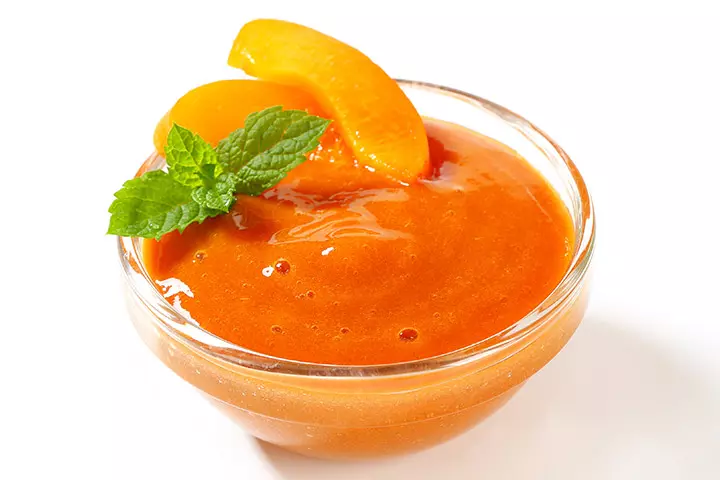
You will need:
- 1 pound dried apricot
- 2 cups pear, white grape juice, or apple juice
How to:
- Boil the ingredients in a saucepan. Then simmer for 15 minutes.
- Transfer the contents into a blender and blend well.
- Add in more juice to get thinner consistency or add cereal to thicken it up.
2. Apple sauce

You will need:
- 1 apple (peeled, cut into slices)
- 2 cups water
How to:
- Boil the apple slices in a saucepan. The slices need to be immersed in water.
- Once done, mash the apple slices. Add water to get the desired consistency.
- You can add a dash of cinnamon to the puree to enhance its palatability. Alternatively, you may boil a small cinnamon stick with apple slices and remove it before mashing the slices to puree.
A mom of two, Umaima is a blogger who loves developing healthy recipes for her children. In one of her kitchen adventures, she flavored her six-months-old’s apple puree with cinnamon and noted her reaction. She says, “Instead of adding cinnamon powder to the puree, I steamed the apple with a cinnamon stick. It ensured that only the lovely aroma of cinnamon penetrated the apple, lightly flavoring its flesh. Voila, Nabeel gulped the spiced cinnamon apple puree with gusto (i).”
3. Banana puree
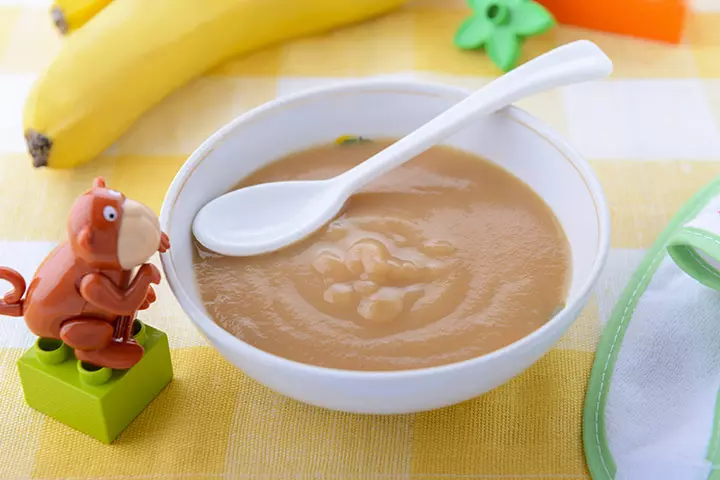
You will need:
- 1 ripe banana (peeled and diced)
How to:
- Blend the banana in a food processor or mash it in a bowl.
- Heat the mashed content for 25 seconds for added softness.
- Add milk or water to make it thinner or cereal to thicken it.
4. Mango delight

You will need:
- 1 ripe mango (peeled, de-seeded, chunked)
How to:
- Blend the mango chunks in a food processor.
- Add in breast milk or formula milk to achieve the desired consistency.
5. Pea puree
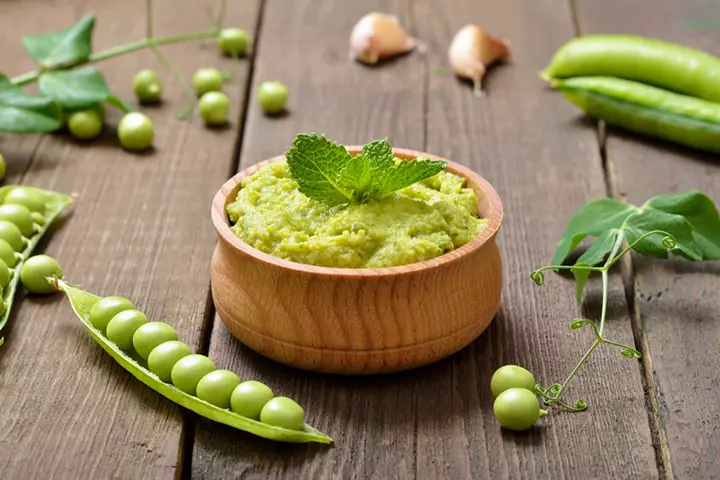
You will need:
- Frozen or fresh peas
- Breast milk, formula, or water
How to:
- Fill a saucepan with water and let it boil.
- Once the water starts boiling, place two cups of peas in a steamer basket over the pot or saucepan.
- Cover the lid and allow the peas to steam for three to five minutes.
- Once the peas start looking bright green, tender, and fresh, remove the steamer basket from the pot and let the peas cool.
- Blend the peas in a blender or a food processor into a puree.
- Add breast milk, formula, or water to get the desired consistency.
6. Avocado puree

You will need:
- One ripe avocado
- Breast milk, formula, or water
How to:
- Cut the avocado into half and remove the pit.
- Use a spoon to scoop out the flesh.
- Blend the scooped avocado into a puree using a blender or food processor.
- You may also use a fork to mash the avocado well.
- Add breast milk, formula, or water to get the desired consistency.
Lunch Recipes
7. Rice cereal
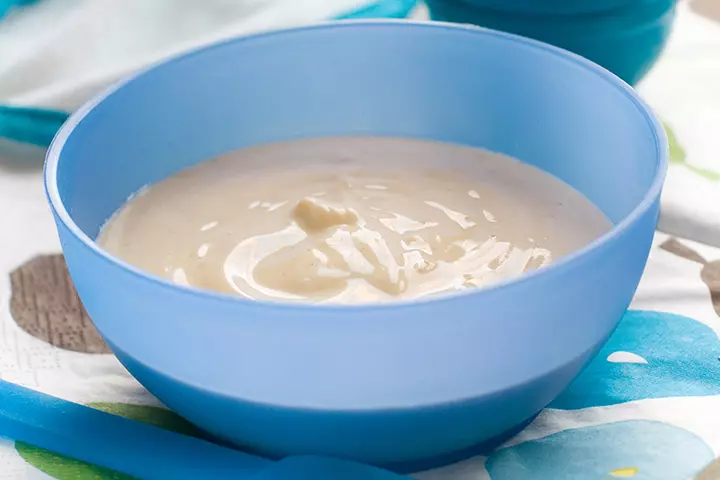
You will need:
- 1/4 cup rice
- 1 cup water
- 2 tbsp formula or breast milk
How to:
- Wash the rice and cook it in a saucepan or pressure cooker.
- Mash the cooked rice and add formula or breast milk.
8. Barley apple porridge

You will need:
- 1/4 cup ground barley
- 3.5 cup water
- 2tbsp formula or breast milk
- 1 cup peeled and cubed apple
How to:
- Boil water in a saucepan and add barley.
- Cook in the simmer for 10 minutes.
- Add apple slices and cook on low heat for two minutes.
- Puree the contents using a hand blender.
9. Oatmeal cereal
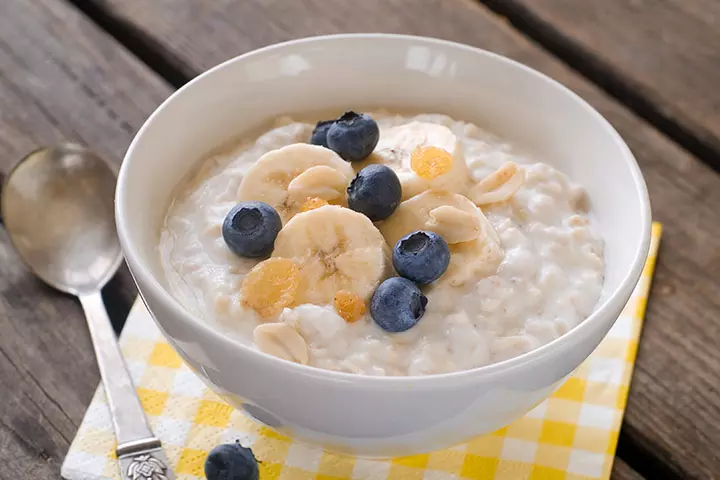
You will need:
- 1/3 cup water
- ¼ cup ground oats
- 2tbsp formula or breast milk
- ½ banana sliced
How to:
- Take a saucepan, add water, and bring it to a boil. Add oats and cook in the simmer for 10 minutes.
- Once done, add bananas and mash well. Add formula or breast milk to get the desired consistency.
10. Baked applesYou will need:
- 1 apple (peeled, cored)
How to:
- Spread butter on the cored apple and put it in a pan containing water.
- Preheat the oven to 400°F and place the pan in it.
- Bake the apple for 30 minutes.
- After baking, mash the apples to the desired consistency.
Dinner Recipes
11. Pumpkin puree
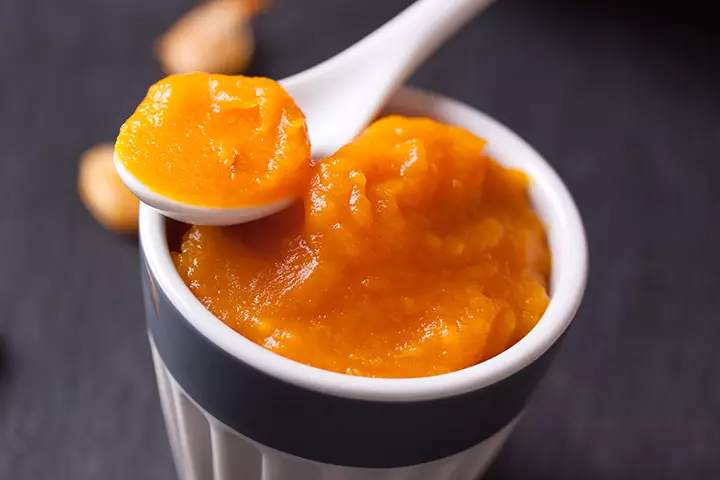
You will need:
- 1 medium sugar pumpkin (cut in half and De-seeded)
How to:
- Scoop out the seeds from the sugar pumpkin halves and drain the pumpkins with water in a baking pan.
- Bake for 40 minutes in the oven preheated to 400°F. Once the halves turn soft, scoop the squash meat and puree it in a food processor. Add water to achieve a smooth consistency.
12. Green beans puree

You will need:
- 1 cup fresh beans
How to:
- Transfer the beans into a pan and place it in a steamer basket.
- Steam until tender. Keep a check on the water level.
- Once done, puree the contents in a blender and bring it to a smooth consistency.
13. Carrots puree

You will need:
- 1 carrot (sweet, peeled, cut)
How to:
- Transfer the carrot slices into a steamer pan containing water. Steam until the carrots turn tender.
- Place the contents into a blender and puree them. Add water if needed.
Blogger Christine Gallary shares her experience of realizing why her daughter enjoys carrot puree so much. She says, “My daughter’s always loved carrot puree — she’ll clap her hands and scrape every last bit out of her bowl, but I never thought about why until I absentmindedly tasted it one day myself: yum! (ii)“
14. Vegetable combo
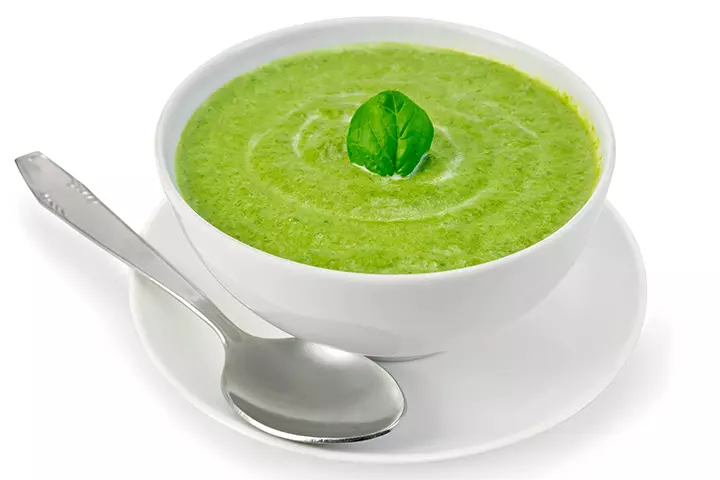
You will need:
- 1/8 cup fresh beans
- 1/8 cup peas
- ¼ cup summer and zucchini squash
- 1/8 cup chopped carrots
How to:
- Add all the ingredients to a pan and add enough water.
- Cook until tender and puree the contents in a blender.
- Add water to get the desired consistency.
With such interesting recipes, it is likely that your baby would love her new diet. But you cannot feed her beyond small quantities just because she has developed a liking for it.
How Much Should A Six-Month-Old Eat?
Start with servings of 5-10ml or one-two teaspoons and increase the amount gradually. The baby may eat just half a spoon initially. Do not force-feed them.
Also, moving to solids is not easy as you need to be careful not to choke the baby or hurt their tummy with heavy foods. Take enough care not to harm the baby when you are feeding solids.
Heat food to lukewarm. Avoid heating it in the microwave as it creates pockets of heat that can burn the baby’s mouth. Instead, keep the food bowl in a bigger bowl of boiling water to heat it.
Caution While Preparing Stage 1 Baby Food
Kristen Carli, a registered dietitian from Scottsdale, Arizona, says, “Avoid added sugar or salt at this age. You can incorporate all other spices such as garlic powder, ground cumin, and ground coriander. When introducing the allergen foods, be sure to add them individually. This will help you identify which food is causing an allergic reaction.”
- Do not give cow milk to babies under one year. Also avoid honey, since it may contain spores that cause botulism.
- Never give slices of fruit or other finger foods to six-month-olds because it could choke them.
- Refrain from store-bought baby foods as they are usually extremely sweet, acquainting the baby to a taste for sweet foods instead of healthy natural foods.
- Introduce one fruit at a time and check for any allergic reactions. Follow a four-day wait rule in between two new foods.
- When starting solids, it’s important to introduce allergen-free foods and monitor your baby for any signs of allergic reactions.
- While convenient, be mindful of using too many baby food pouches and opt for BPA-free containers when preparing and storing homemade purees.
- Avoid biscuits as they contain refined flour, preservatives, and added sugar.
- Wash your hands before feeding your little one.
- Ensure the fruits and vegetables for babies are fresh and washed well.
 Quick tip
Quick tipAllergy Awareness For Six-Month-Old Baby
The Asthma and Allergy Foundation of America reports that food allergies affect around 4 million US children, making up 5.8% of the child population (7). Therefore, it’s crucial to be aware of potential allergens when introducing new foods to your baby. Common allergens include peanuts, tree nuts, dairy, eggs, wheat, soy, fish, and shellfish. Introduce these foods one at a time, starting after your baby has successfully tried several other foods without issues. Monitor for any signs of allergic reactions such as hives, difficulty breathing, diarrhea, vomiting, itching, or swelling, and consult your pediatrician for timely guidance and personalized care (8).
Tips To Feed A Six-Month-Old Baby
Introducing 6-month baby food to your child is an exciting milestone. Here are practical tips to create a positive and safe eating environment, promoting healthy eating habits in your child (9) (10):
- Make them sit in an upright position: Before feeding, ensure your baby is seated upright to aid digestion and prevent choking.
- Prioritize comfort: Make sure your baby is comfortable by keeping diapers dry and addressing any teething pain or issues like sore throats or constipation.
- Eat together: Demonstrate how to pick up food, chew, and swallow, showing your baby through your actions.
- Choose a calm location: Feed your baby in a calm and pleasant environment, giving them time to enjoy their meal.
- Encourage messiness: Allow your child to touch and explore their food while learning to self-feed.
- Employ hands-off approach: Resist the urge to immediately clean up spills or prevent messiness while your child learns to self-feed.
- Know when to stop: Do not force feed. Look for signs of fullness and stop feeding when your child indicates they are done.
Frequently Asked Questions
1. How many times in a day should I feed solids to my six-month-old?
In addition to continued breast or formula feeding, six-month-olds need to be fed soft solid foods twice a day, which can include two to three spoonfuls of smooth, lump-free puree, mash, or porridge (11).
2. Can I give eggs to my six-month-old baby?
Fresh, warm, and firmly cooked eggs can be included in the 6 months baby food diet (12). Studies suggest that feeding eggs to children can significantly contribute to their growth and development (13).
3. What can a baby drink at six months?
Babies between 6 and 12 months of age can drink 4 to 8 oz. water daily along with continued breast or formula feeding. You can introduce appropriate 6-month baby food for their nutritional needs (14). Generally, experts recommend avoiding fruit juices for babies under 12 months (15). However, you may occasionally give your baby 4 to 6 oz. of unsweetened fruit and vegetable juices (16).
4. How can I know if my baby is ready for solid foods?
To determine if your baby is ready for solid foods, ensure they can sit up straight with minimal assistance, allowing for comfortable swallowing and proper digestion. They should also have good head and neck control while sitting. Look for signs of curiosity, such as watching others eat, reaching for food, or opening their mouth when handed a spoon, indicating a desire to try solids (17).
5. How can parents minimize picky eating and establish healthy eating habits?
You may reduce picky eating and help your baby develop healthy eating habits by introducing a variety of nutritious meals early on, including fruits, vegetables, and whole grains. Allow your child to explore diverse textures and flavors at their own pace by serving small quantities of food. Avoid using food as a reward or punishment, and be patient with repeated introductions to new foods (18).
6. How should I ensure there are no choking hazards in the puree?
When preparing purees for your baby, safety should be a priority. To avoid choking risks, ensure the texture is smooth, soft, and free of food particles. Use a blender or food processor to achieve this consistency effectively. For tougher vegetables and fruits such as carrots and apples, cook them until soft. Remove any tough skins to further minimize choking hazards (19).
7. How should I store leftover baby food for later use?
Once you have finished preparing the puree and if you plan to use it within a day or two, store it in a tightly sealed container in the refrigerator. However, for longer-term storage, freezing is an ideal approach. Label each container with the food type and date of preparation (20). Remember to store only freshly prepared food; any served but uneaten food should be discarded.
Most babies can begin eating solid foods from six months of age. For example, you may include rice, apple, oatmeal, meat, fish, and sweet potato in easy-to-swallow puree and mash forms in your six-month baby food. Initially, serve the baby one to teaspoons of baby food and watch the signs of food intolerance and allergies. Once the baby adjusts to the taste and digestibility of these single-ingredient foods, you can feed them multiple ingredients dishes, such as a vegetable combo.
Infographic: Recipes For Six-Month-Old Baby
As a parent or caregiver of a six-month-old, it is essential to gradually introduce solid foods. You may begin with a spoonful of pureed food and increase the quantity and variety as your baby becomes more accustomed to eating solid foods. Check out this infographic for a list of options to start with.
Some thing wrong with infographic shortcode. please verify shortcode syntaxIllustration: 6-Month-Old Baby&039s Food Chart And Recipes
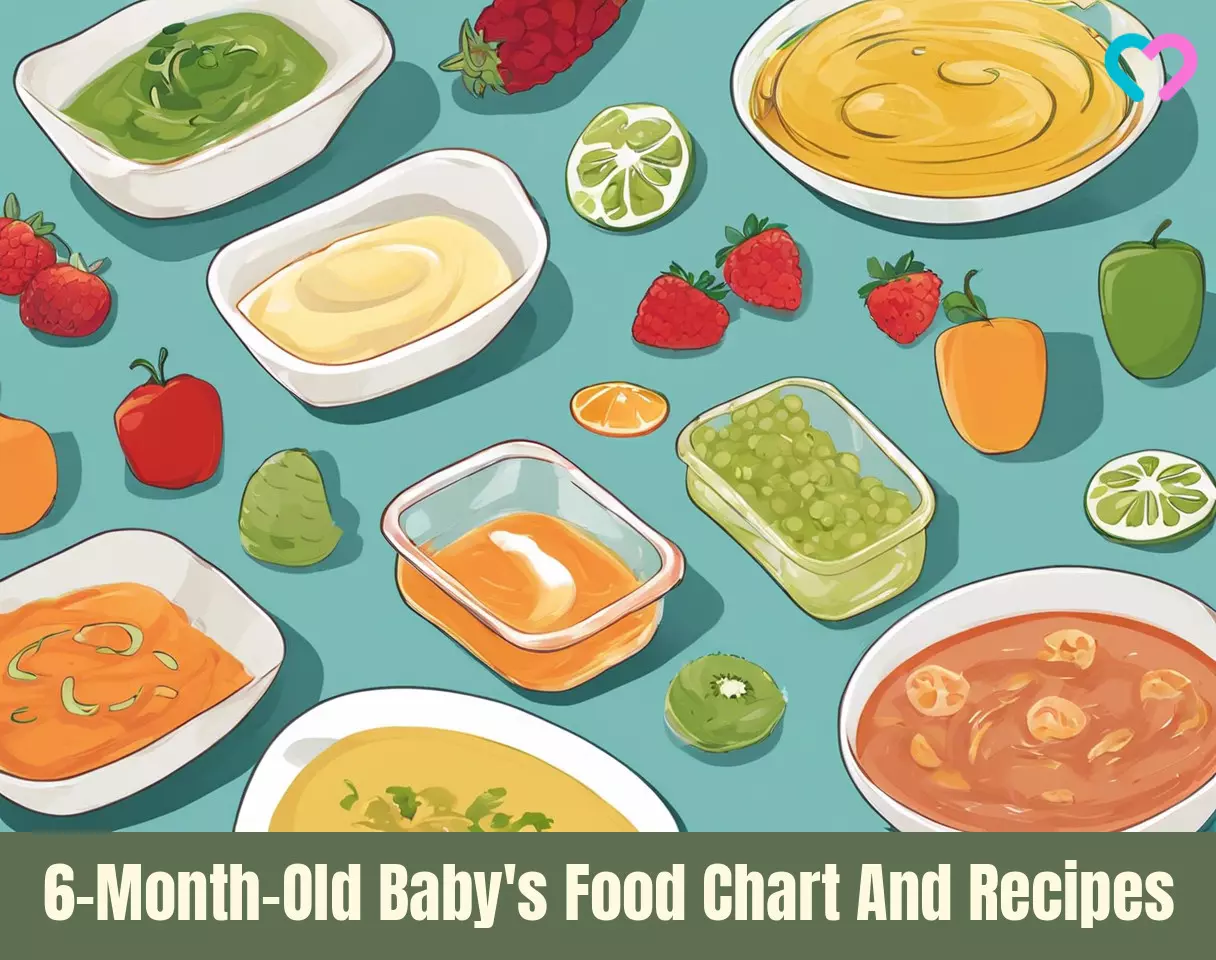
Image: Stable Diffusion/MomJunction Design Team
Explore three delicious and nutritious recipes for your baby aged 6 months and older. Learn the art of preparing these delightful and nourishing meals for your little one by watching this easy-to-follow instructional video.
Personal Experience: Sources
MomJunction articles include first-hand experiences to provide you with better insights through real-life narratives. Here are the sources of personal accounts referenced in this article.
i. Baby Food 0 To 9 Months; Steamed Apple Recipe – Baby Food;
https://beingamommyblog.wordpress.com/2014/08/07/steamed-apple-recipe-baby-food/
ii. Carrot Puree Is Baby Food That Grownups Should Love Too;
https://www.thekitchn.com/why-carrot-puree-isnt-just-for-babies-212802
References
- Infant Food and Feeding.
https://www.aap.org/en/patient-care/healthy-active-living-for-families/infant-food-and-feeding/?srsltid=AfmBOopW3QGBukfht3TYCvhJdjcuNIipXifWoQD738pq7I1sLC7JkhC4 - Boquien Yves.; Human Milk: An Ideal Food for Nutrition of Preterm Newborn.
https://pmc.ncbi.nlm.nih.gov/articles/PMC6198081/ - Introducing solids: why when what and how.
https://raisingchildren.net.au/babies/breastfeeding-bottle-feeding-solids/solids-drinks/introducing-solids - Feeding Your Baby: 6 months to 1 year.
https://www.gov.mb.ca/fs/healthybaby/index.html - Policy Statement: Breastfeeding and the Use of Human Milk.
https://publications.aap.org/pediatrics/article/150/1/e2022057988/188347/Policy-Statement-Breastfeeding-and-the-Use-of - Feeding Guide for the First Year.
https://www.stanfordchildrens.org/en/topic/default%3Fid=feeding-guide-for-the-first-year-90-P02209?undefined - Allergy Facts.
https://aafa.org/allergies/allergy-facts/#:~:text=About%2016%20million%20(6.2%25)%20U.S.%20adults%20have%20food%20allergies.&text=About%204%20million%20(5.8%25)%20U.S.%20children%20have%20food%20allergies - Food Allergies in Children.
https://www.hopkinsmedicine.org/health/conditions-and-diseases/food-allergies-in-children - Introducing Your Baby to Solids.
https://www.nct.org.uk/information/baby-toddler/feeding-your-baby-or-toddler/introducing-your-baby-solids - Starting Solid Foods: Practical Tips.
https://raisingchildren.net.au/babies/breastfeeding-bottle-feeding-solids/solids-drinks/solid-foods-practical-tips-for-getting-started - Feeding your baby: When to start with solid foods
https://www.unicef.org/parenting/food-nutrition/feeding-your-baby-when-to-start-solid-foods - Safe Food for Babies and Children
https://www.ndsu.edu/agriculture/extension/publications/safe-food-babies-and-children-making-homemade-baby-food-babies-6-months-and - Yanni Papanikolaou et al.; (2018); Egg Consumption in Infants is Associated with Longer Recumbent Length and Greater Intake of Several Nutrients Essential in Growth and Development.
https://www.ncbi.nlm.nih.gov/pmc/articles/PMC6024369/ - Foods and Drinks to Encourage.
https://www.cdc.gov/infant-toddler-nutrition/foods-and-drinks/foods-and-drinks-to-encourage.html?CDC_AAref_Val=https://www.cdc.gov/nutrition/infantandtoddlernutrition/foods-and-drinks/foods-and-drinks-to-encourage.html - AAP Recommends No Fruit Juice for Children Under 1 Year.
https://www.healthychildren.org/English/news/Pages/AAP-Recommends-No-Fruit-Juice-for-Children-Under-1-Year.aspx - Infant Feeding Guide
https://www.urmc.rochester.edu/encyclopedia/content.aspx?contenttypeid=90&contentid=P02694 - Your Baby’s First Solid Foods.
https://www.nhs.uk/conditions/baby/weaning-and-feeding/babys-first-solid-foods/ - 10 Tips for Parents of Picky Eaters.
https://www.healthychildren.org/English/ages-stages/toddler/nutrition/Pages/Picky-Eaters.aspx - Choking Prevention And Choking Risks.
https://raisingchildren.net.au/toddlers/safety/choking-strangulation/choking-prevention - How to Make Homemade Baby Food.
https://www.eatright.org/health/pregnancy/babys-first-foods/how-to-make-homemade-baby-food - Feeding your baby: 6–12 months.
https://www.unicef.org/parenting/food-nutrition/feeding-your-baby-6-12-months
Community Experiences
Join the conversation and become a part of our nurturing community! Share your stories, experiences, and insights to connect with fellow parents.
Read full bio of Dr. Hanneke Heyns
- Kristen Carli is a registered dietitian with private practice, Camelback Nutrition and Wellness, in Scottsdale, Arizona. She also runs a blog, Mostly Green, which shares original plant-based recipes. Kristen did her MS from Arizona State University and has five years of experience in the field.
 Kristen Carli is a registered dietitian with private practice, Camelback Nutrition and Wellness, in Scottsdale, Arizona. She also runs a blog, Mostly Green, which shares original plant-based recipes. Kristen did her MS from Arizona State University and has five years of experience in the field.
Kristen Carli is a registered dietitian with private practice, Camelback Nutrition and Wellness, in Scottsdale, Arizona. She also runs a blog, Mostly Green, which shares original plant-based recipes. Kristen did her MS from Arizona State University and has five years of experience in the field. - Blanca Garcia has been a registered dietitian nutritionist since 2013 with a private practice in Pasadena, California. She currently consults through the preschool Head Start Programs in Los Angeles. Blanca graduated in 2011 from California State University of Los Angeles and interned at the University of Puerto Rico Medical Science campus in 2012.
 Blanca Garcia has been a registered dietitian nutritionist since 2013 with a private practice in Pasadena, California. She currently consults through the preschool Head Start Programs in Los Angeles. Blanca graduated in 2011 from California State University of Los Angeles and interned at the University of Puerto Rico Medical Science campus in 2012.
Blanca Garcia has been a registered dietitian nutritionist since 2013 with a private practice in Pasadena, California. She currently consults through the preschool Head Start Programs in Los Angeles. Blanca graduated in 2011 from California State University of Los Angeles and interned at the University of Puerto Rico Medical Science campus in 2012.
Read full bio of Swati Patwal
Read full bio of Rohit Garoo
Read full bio of Vidya Tadapatri









